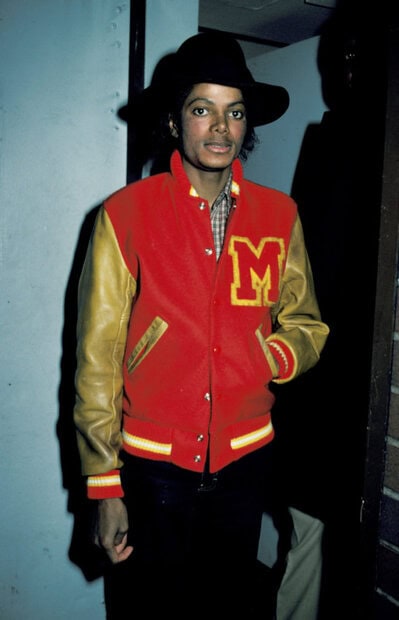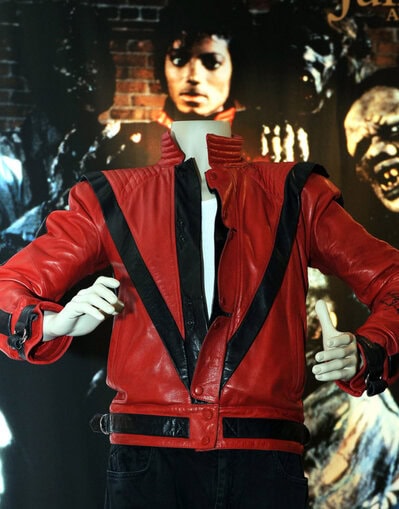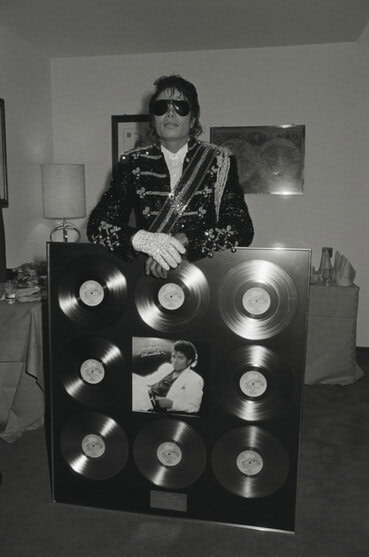The ultimate victory lap, learn how the King of Pop’s $1 million short film changed the course of Billboard, MTV, and VHS.
Holiday shopping isn’t easy when you have nine siblings.
Heading into December of 1983, Michael Jackson likely had a laundry list full of friends and family expecting Christmas gifts. Selling a million albums a week for months on end, the newly-crowned King of Pop was accumulating more income than most moguls could imagine.
As the second-youngest of 10 kids, even Janet was too old to ask the elder Michael for the Cabbage Patch dolls that were sweeping the nation.
Instead, MJ angled to give friends, family, and fans more than they could ever imagine: one final single from his hit album, Thriller.
Seeing the success of “Billie Jean” and “Beat It” on both radio and television, Jackson skipped over ballads like “Lady in My Life” or feel-good singalongs such as “Baby Be Mine.” Instead, he leaned into shock value and scare, picking the title track as the final curtain call for the best-selling album of all time.
And with that momentous decision, the holiday season would become spooky season.
Close to midnight but closer to Christmas, it was time to up the ante on film, freight, and financing with the million-dollar music video for “Thriller.”
Years in the Making
In the spring of 1982, Michael Jackson and producer Quincy Jones headed to Westlake with a $750,000 budget and great expectations.
Years earlier, the two linked for 1979’s Off the Wall, a disco dance record that set the Jackson 5 frontman apart from the pack.
While the solo smash topped Billboard’s R&B Album charts for 16 weeks straight, it failed to hit No. 1 on the overall Billboard 200. Even though Michael had been entertaining a national audience before he could ride a bike, both the industry and the audience remained segregated where commercial success was concerned.
Headed to California with cash and equipment, Jackson and Jones aimed to make an album where every song was not just a single — it was a killer.
An early entry proved “Starlight,” a post-disco dance record written by Rod Temperton.
Climactic while still fit for roller rinks and radio, Temperton felt it could be bigger if renamed to “Thriller,” seeing it as a branding opportunity that could take to t-shirts like Hulkamania.
Better yet, it could be scary. While Jackson’s fanbase adored dance songs and ballads, the artist’s personal life was more and more encompassed by fear and paranoia. Making a single and an album that was darker in themes and tones could catapult him to adult status when considering an audience that still saw him as a little kid.
After months of tinkering in California, Jackson, Jones, and Temperton finished Thriller the album, releasing it on Nov. 30, 1982.

Initially, sales were slow. A Paul McCartney duet failed to capture its intended crossover audience. In the early going, charts favored Hall & Oates and Men at Work.
But all the while, Jackson shot content in hopes of getting airplay on MTV, a game-changer where visibility, artistry, and record sales were concerned.
Tik-Tok before Tik-Tok, Music Television was exactly what it sounded like, feeding audio-obsessed listeners with mini-movies set to their favorite songs. In the early days of MTV, however, rock and roll was king, with African American artists like Jackson still struggling to get airtime.
In a matter of months, Jackson sent over the visual for “Billie Jean.” A host of industry executives quickly considered it to be the best music video they had ever seen.
Shot, directed, and edited at a higher level than anything guitar-driven at that time, the code had been cracked and the floodgates were open.
Right on cue, Thriller started to shoot up the charts that spring as kids sat in front of the boob tube hoping to catch the album’s second single in video form.
Doubling down while pandering to the platform, Jackson followed “Billie Jean” with the video for “Beat It.”
Amplified by an Eddie Van Halen shred session and Westside Story narrative, Jackson owned the camera and stole the show. Not only was MTV playing the track with high frequency, but rock radio was picking it up. The Westlake brain trust had successfully taken over a world that once wouldn’t let them in.
By the summer of ’83, Thriller couldn’t be kept on shelves. Three more singles had been added to radio rotation while MJ’s brothers begged him to make another Jackson 5 album.
With more money in the bank than a kid from Gary, Indiana could ever dream of, the eighth-youngest Jackson spent the fall of ’83 focused on taking his hit LP to even higher heights.
It was time to make one last music video for Thriller, and it had to top the first two.
All it took was a budget even bigger than that of the album itself.
House of Horror
Few icons elicit emotional responses like Michael Jackson. For the better part of 1983, the King of Pop had fans screaming, dancing, and crying in both hemispheres.
Taking over televisions, the reclusive chart-topper would emerge publicly only on occasion, drawing crowds of thousands if only appearing for seconds.
When at home, the music video visionary proved a fan of film, falling in love with John Landis’ comedic horror feature An American Werewolf in London.
Honing the ability to make watchers laugh with joy and recoil in fear was something Jackson had not yet done.
The key was recruiting Landis. Once on board, the Chicago-born director behind National Lampoon’s Animal House and the Gary kid who ruled radio began writing a video treatment for “Thriller” the song, full of references to the scariest scenes in horror movie history. A movie within a movie, Jackson brought in a $1 million budget for the visual, eclipsing entirely what it took to make Thriller the album.
Catching the same cable network by the tail that had gate-kept him only years prior, MTV ultimately promoted the premiere of the music video as an exclusive event. On Dec. 2, 1983, just a few short weeks before Christmas, Jackson turned television sets nationwide right back into full-fledged Halloween mode.
Coming in at 13-minutes long — an inordinate time for a single music video and a lengthy window to elapse with no ad breaks besides — “Thriller” absolutely enthralled fans.

Too terrifying for children and too riveting to look away, the theatrics of “Billie Jean” and “Beat It” were bested by miles when it came to storytelling, wardrobe, and choreography.
Even the short film’s font was scary, proving Temperton’s foresight to sell the song and album’s imagery on t-shirts.
Quickly, Michael merch from cotton crewnecks to red leather jackets were bankable items. Not only would fans consume Thriller like mad on vinyl and cassette; they’d advertise it through their apparel.
On the surface, the magnitude of the music video was colossal. Jackson kicked down the door for African American artists angling for MTV airplay, and he additionally raised the visual bar for rock royalty and pop peers alike.
Music videos were not merely a marketing afterthought — they became the premier play for true artists.
With “Thriller,” Jackson, Jones, and Temperton danced all over the doubters who thought their music didn’t have crossover cachet.
The video itself was bigger than most albums and enough to own both Billboard and MTV for another year to come. In fact, fans wanted to watch “Thriller” so badly that MTV advertised when it would air again after each broadcast.
The result? MTV’s ratings increased tenfold.
Still, there was more to be marketed.
Cinematic Superstar
Weeks before “Thriller” had fans waiting worldwide in front of their home television sets, Michael Jackson played the clip for famous friends at the Crest Theater in Los Angeles.
In the audience, the likes of Eddie Murphy, Warren Beatty, Diana Ross, and even Prince watched with bated breath. Up in the projector booth, Jackson pressed play himself, declining a seat next to his performer peers. Thirteen minutes later, the attendees hopped out of every last seat to give MJ a standing ovation.
Never one to be shy, Eddie Murphy asked if he could play it again. Michael did.
Before fans could clamor with the same shock and enthusiasm as Hollywood’s elite, Jackson knew exactly what he was onto. Not only was “Thriller” going to take a small fortune to film; the filming itself would be something to document and sell as well.
Much like his father, Joe Jackson, MJ was a shrewd businessman. Alongside the MTV premiere of the music video, the Making Michael Jackson’s Thriller documentary debuted in parallel. Showing behind-the-scenes footage from dance practices to the mountains of makeup applied to each ghoul and goblin, Jackson had a meta-hit on his hands.
Utilizing his leverage, Jackson got MTV to pay $250,000 for exclusive rights to show the documentary on cable. On top of that, Showtime put up $300,000 for the pay-channel rights.
Just like that, major media outlets had funded the making of “Thriller” in both a literal and figurative sense.
Even before that, the two networks financed the music video itself, splitting the budget 50/50 when Epic declined to help. In turn, they surpassed the dollar amount that Epic allotted to make Thriller the album in the first place.
By investing in his art and applying the right pressure to the platforms, all releases and accessories tied to Thriller absolutely crushed up and down the marketplace.
Not only did “Thriller” the music video keep the album itself atop the charts, but all of the project’s behind-the-scenes footage was packaged and sold in VHS form. In a deal with Vestron Music Video, MJ bypassed Blockbuster rentals to sell copies of the documentary straight to fans. Even sweeter, Vestron put up $500,000 to market it.
The VHS tape sold a million copies itself, a record at that time that not only shook an adjacent industry, but still connects with fans today, particularly now that MTV spends little time showing videos, and certainly not the 13-minute variety.
Still Streaming
In 2022, the “Thriller” music video has amassed over 855 million views on YouTube alone.
Even an abridged version has hit the 181 million mark, while a split-second GIF garners thousands of social shares every time something in pop culture is deemed worthy of popcorn commentary.
Both critically and commercially, “Thriller” tops all music video lists even 39 years after its arrival. Since spending $1 million on the short, the entire industry has chased the same success while rolling out bigger budgets.
As expected, MJ always led the charge and pushed the envelope.
For the first single and title track off Bad, Jackson brought in Martin Scorsese and spent $2.2 million. Years later, he joined sister Janet on the set of “Scream,” a duet that cost $7 million to shoot.

On top of that, Jackson opened the doors for African American artists like Puff Daddy, Missy Elliott, and TLC to shoot multi-million dollar music videos with record label backinbg.
Directors of color like Paul Hunter, Hype Williams, and F. Gary Gary were also leaders in this cinematic marriage to music, carving a lane that still inspires and feeds creatives today.
As Thriller turns 40 this holiday season, the transcendent art form has proved viable in vinyl and VHS, still streaming to massive fanfare in 2022.
While allegations against the deceased Jackson have understandably repositioned the public perception around him as a person, the “Thriller” music video maintains a revered place in pop culture history.
Going against the grain and resetting the industry, the $1 million spectacle made millions for MTV, Michael, Epic, and clothing companies.
According to Michaelangelo Matos’ book Can’t Slow Down, MJ had made $50 million off of Thriller by the fall of 1984 alone, coming off the heels of the infamous music video released only months prior.
Even in 2022, the clip still holds its weight.
Around the world, plenty of “Thriller”-inspired costumes populate parties while viral clips inspired by the video’s iconic dance scene continue to be uploaded on all platforms.
But back in the winter of 1983, times were simpler even if MJ’s aspirations were more complex. In fact, it was those very VHS tapes that ended up giving Cabbage Patch dolls and Transformers figurines a run for their money.
A cash cow then and still a cash cow now, Michael Jackson’s frightening mini-movie proved an absolute killer on vinyl, video, and even apparel.
Scary, isn’t it?
Read More
- MLB All-Stars Sound Off: Automatic Ball-Strike Challenge, Changing the Game, & More
- MLBPA Leader Tony Clark Talks Salary Cap, Revenue Sharing, Winning
- Emmy Nominations Prove There’s Too Much Great TV and Not Enough Room
- Did MLB Finally Crack the Code to the All-Star Game?
- What FIFA Got Right (and Wrong) with the Club World Cup